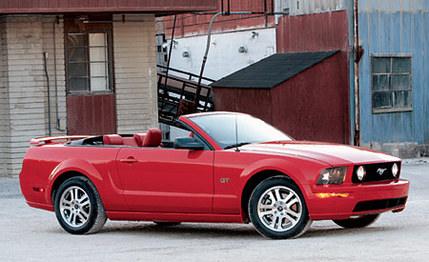 Road Test
Road Test
William Clay Ford Jr., scion of the house that Henry built, current chairman and CEO of the Ford Motor Company, has said more than once that if he could have only one car it would be a Mustang, specifically, a Mustang with a "throaty V-8." We infer the Mustang would be of the convertible variety, the better to hear the sounds issuing from the V-8's throat—make that throats, as in twice pipes—and having finally put the spurs to Ford's latest droptop pony car on test track and byway, we offer the following conclusion: Yo, Billy! Here's your car!
Do you reject the notion of a Fortune 500 CEO transporting himself in a mere Mustang, when the corporate parking lot also includes Jaguars and Aston Martins? Hey, why not? Beyond the charms of the car itself, there is also a powerful element of heritage. Ford counts every Jag and Aston ever built in its total production tally, but it's impossible for the home office in Dearborn to make a credible claim on the actual founding of either subsidiary, whereas the Mustang is all-American and home-grown in the Motor City. And as a compelling footnote, the first Mustang sold 41 years ago was a convertible, replete with a throaty V-8.
Billy Ford's preferences notwithstanding, there are two questions to be answered here: How does the performance of the convertible Mustang GT stack up against that of the coupe? And what's the verdict on structural rigidity? Since the second question is the key to sorting the firm from the flabby in convertibledom, let's tackle that one first. In our March preview drive, our man Winfield reported that Ford's chassis-stiffening measures had damped out all but a modicum of "vibration or movement through the steering wheel, with insignificant levels of windshield-frame tremor." He went on to note that the foregoing was "evidence of good cowl rigidity and a tightly constrained structure."
Winfield's observations were rooted in a short day of driving on California highways. Having exercised a convertible on Michigan roads, we find we must amend our preview take—but not much. On pavement textured with frost heaves and potholes, the Mustang's chassis does exhibit the occasional quiver, and on really severe bumps, the cowl can be seen to jiggle now and then. However, referring to this as cowl shake seems unfair, since there are cowl shakers out there that make the Mustang look like it was carved from billet.
Ford says the droptop Mustang's torsional rigidity torques out at 6500 pound-feet per degree of twist. The old convertible was rated at 3000. Also, bending rigidity—imagine a giant grabbing both ends of the car and trying to fold it like a piece of taffy—is up by 25 percent, according to Ford. Remarkably, chief engineer Hau Thai-Tang (since elevated to directorship of Ford Advanced Product Creation and SVT programs) and his troops achieved this starting with some of the same basic bones employed in the foundations of the soon-to-be-discontinued Thunderbird, a cowl-shake poster car. Moreover, they did it without achieving T-Bird bulk. The last Thunderbird we tested [ C/D, August 2003] weighed in at 3800 pounds. Our GT convertible tester scaled 3673, 150 pounds heavier than the first '05 GT coupe we tested [ C/D, December 2004] and just 98 pounds heavier than the one that prevailed against the latest Pontiac GTO in a head-to-head shootout ["Goat and Pony Showdown," C/D, January 2005]. Why the difference? Different option packages. And what did the extra mass do to acceleration?
We'll get to that in a minute. First, let's put those abstract chassis-rigidity numbers into real-world perspective. As noted, the Mustang GT's body shell can be provoked into quivers, but there's nothing to remind you of the rubbery reactions of a droptop like Toyota's Camry Solara, the boneless chicken of convertibles. On the great scale of ragtop rigidity, we'd rank the Mustang GT a little behind railroad trestles like the Honda S2000, Corvette convertible, and Porsche 911 cabriolet but on a pretty equal footing with respectable entries like the BMW 3-series, Audi A4, and Mercedes CLK—and for far less dough.
The extra mass associated with convertiblization ordinarily shows up as a debit in the acceleration column, but that wasn't the case here. Even though our droptop tester had only 300-plus miles on the odo when it went to the test track, at 5.0 seconds to 60 mph, it was quicker than either of the coupes we've tested, which ran 5.2 seconds and 5.1, respectively. The convertible also turned in the best quarter-mile time—13.7 seconds at 103 mph. That's just a 10th quicker than the coupes, and trap speeds were essentially the same, but it does indicate that the 4.6-liter SOHC 24-valve aluminum V-8 doesn't mind a little extra mass.